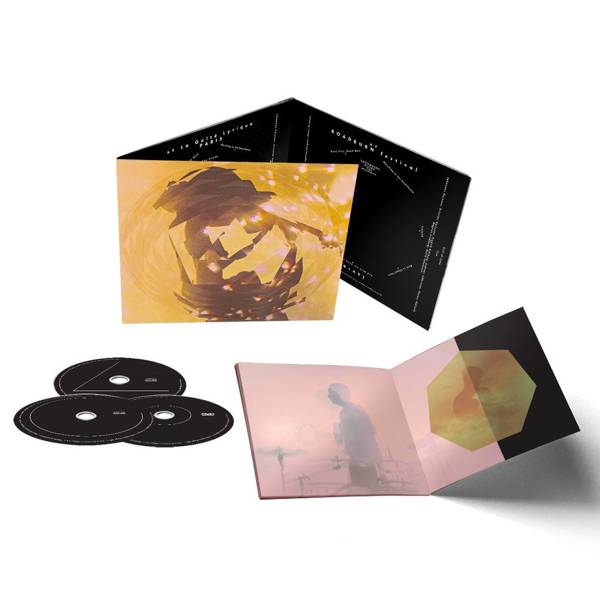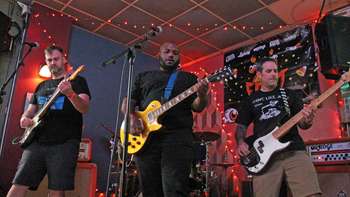Reaching out from Stockholm, Sweden, guitarist/vocalist Johannes Persson of Cult of Luna generously took some time to talk about Cult of Luna, and their newest release, the live DVD/CD Years in a Day.
“To write songs is not about finding chords, [it is] finding different ways of working the chords to write riffs,” says Johannes Persson. Speaking as he hits a chord on an unplugged guitar he adds, “You don’t get a punch in the gut from playing that. If you have an amp cranked up on 10, well, then stuff really happens.”
On Years in a Day, Cult of Luna’s stunning latest release, viewers are able to feel what happens when Cult of Luna goes to 10. The live DVD/CD began making its way to fans in April 2017. Most of Persson’s fall in 2016 was spent editing live footage from a Paris, France live show at La Gaîté Lyrique that would become the DVD featured in Years in a Day. The two live CDs included in the limited edition release capture Cult of Luna’s performances from Roadburn 2013 and 2016.

For Years in a Day, Persson was part of a careful approach to create symmetry between the music and the show in the editing room. The language of music presented in a visual medium, of a live show put to tape, is not quickly coded. To create something visually compelling, something beyond simple coverage, requires a precise timing and pace of the edit. The elements that envelope a viewer’s senses do so by feel rather than flat enforcement. Persson says the 3-month plus process of editing was necessary in getting the most out of the material from the 8 camera shoot.
“You go frame by frame by frame to get the right timing, to get the right editing pace,” he says.
This process, a deeply engrossing and consuming one, is fundamentally in line with they way the band approaches writing, recording, and assembling a record, and playing live. Years in a Day amplifies the lengths to which Cult of Luna reach for their fans and themselves alike.
“I was just excited to get anything out of the amp.”
Persson's pursuit of playing music when he began with the guitar at age 12. He talks about a childhood friend who introduced him to hardcore punk music, and of straying from classical guitar teachings. It was during this introduction to hardcore punk that Persson describes bridging the gap between what he heard on records and what he was able to play.
“All music that I liked, I listened to it, and tried to figure out what they did to make it work. How do they change the riffs, in what order, how do they change the intensity. Stuff like that. I kind of structurally broke down the music I liked,” Persson says.
Persson played in fast hardcore bands before becoming a member of Eclipse, a band that would later split off into separate bands, one of which became Cult of Luna. Persson cites Botch and Coalesce as influences until a moment in the late 1990s when a friend introduced him to the music of Neurosis. The shift that occurred in Persson’s taste and writing style, coupled with a desire to play music with a different dynamic, would shape Cult of Luna. He also mentions Queens of the Stone Age, Darkthrone, and the stoner rock feel of hanging out on one chord for an entire riff as impacting Cult of Luna’s sound.

Cult of Luna
Photo Credit: Maria Louceiro
“I just wanted to go slower and heavier,” he says, describing where he wanted to go after Eclipse.
“For everything we do, we don’t want to do it again,” Persson says reflecting on Cult of Luna's general approach. Their process is about building something from the foundation, up. It’s writing from the heart, collaboratively, and growing an album from a riff into a song and into a group of songs.
“As long as we have a momentum, that we’re not writing the same record,” Persson says of the band’s approach to writing. It’s not about the idea of movement forward or backward, and Persson often uses “momentum” to describe the band’s movement. He goes on to say, “Everything affects what we do after, in a natural way.”
“One way that we are lucky as a band is that we get away with a whole bunch of different stuff. I mean, look...let's just take Vertikal, for example. We have "Passing Through" and we have "I, The Weapon." It’s like two different bands. And we get away with that kind of broad musical style which gives us almost unlimited possibilities to do different things. As long as it stays within the realm of what is Cult of Luna -- and I can not define that; that’s a personal subjective feeling of what we are all about. As long as we feel that we are in that realm--I feel we are unlimited and can do whatever we want.”
For 10 years Persson says that Cult of Luna has been very spread out. The band’s members live in four cities. They meet up for 2-3 days to bring together ideas and return home to contemplate what came out of that session, before returning to further the work on the songs. This process is repeated in order to craft the songs on an album. “Everybody involved in this band are really good musicians,” he explains.
The setlist on Years in a Day is one the band felt good about, and had played for a number of shows on that tour. There’s a presence on the stage that comes with playing a set you are confident in, and for Persson it gives those who watch the most honest presentation of the band.
“I love playing shows. That was the reason why we go through this painful process of writing and recording. To be able to go out and play in front of people and get the connection with the people in the room. That has been my motivation from day 1 basically: doing shows,” Persson says.
"I think, for me, artwork is as important as music to set the tone."
The Years in a Day package contains not only a live DVD inside its 10” vinyl-style packaging, but two live performances on CD as well. On releasing those additional live shows along with the DVD, Persson says, “Instead of releasing one live album here and there, get all the good shows we have out in one package. People that like live recordings, just give them everything we have.”
Nearly 20 years into the Cult of Luna, Persson remains devoted to the process of writing and recording, not only for his own musical desire, but for fans as well. What Persson describes is something of a shared experience among band members, fans and other artists. Persson describes a highly collaborative process with the artists that help craft the visual feel of their releases and shows. Years in a Day is a beautiful example of those collaborations at work.
“Erik Olaffson has done all our artwork since Salvation, and onward, so you know it’s gonna be good when he does stuff,” says Persson.
Persson speaks highly of Olaffson and of the photographer, Maria Louceiro, whose work is also showcased in Years in a Day. He describes Louceiro’s methods, use of analog processes and previous work, with enthusiasm and appreciation. Persson makes it clear that Cult of Luna places a high degree of importance on the artwork in the overall experience, and that the direction of the art weighs heavily on a record.
“We are talking about artwork even before we have stuff written. The artwork is in line with the basic idea.” Persson says as he recalls moments early in the writing process for Vertikal where Olaffson introduced color samples, and of concepts and artwork developed for Mariner as the album was written.
“I think, for me, artwork is as important as music to set the tone.” Persson traces this importance to impressions made upon him in his own listening. He became aware in his own listening experiences that the artwork was a valuable element in communicating an idea before listening to the music.
After spending the fall assembling Years in a Day, and witnessing its successful release in April 2017, Cult of Luna is now preparing for festivals, and tour dates with Julie Christmas. Christmas, who joined the band for Mariner and a run of live shows thereafter, will again join them for dates in the United States and Canada.
“She’s just amazing,” Persson comments as he recalls early rehearsals.
Persson sounds good talking about work and his family. His comments about music are compelling; his descriptives are eloquent.
“Right now," he says, "I’m living life, so to speak.”













